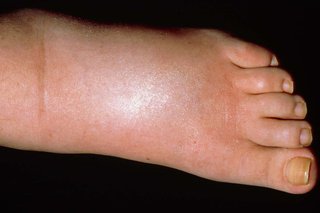How To Get Rid Of Swollen Ankles
Swelling in the ankles, feet or legs often goes away on its own. See a GP if it does not get better in a few days.
Common causes of swollen ankles, feet and legs
Swelling in the ankles, feet and legs is often caused by a build-up of fluid in these areas, called oedema.
Oedema is usually caused by:
- standing or sitting in the same position for too long
- eating too much salty food
- being overweight
- being pregnant – read about swollen ankles, feet and fingers in pregnancy
- taking certain medicines – such as some blood pressure medicines, contraceptive pills, antidepressants or steroids
Oedema can also be caused by:
- an injury – such as a strain or sprain
- an insect bite or sting
- problems with your kidneys, liver or heart
- a blood clot
- an infection
Check if you have oedema
Symptoms of oedema include:


How to ease swelling yourself
Swelling in your ankles, feet or legs should go away on its own, but there are some things you can try to help.
Do
-
lie down and use pillows to raise the swollen area when you can
-
get some gentle exercise, like walking, to improve your blood flow
-
wear wide, comfortable shoes with a low heel and soft sole
-
wash, dry and moisturise your feet to avoid infections
Don't
-
do not stand or sit for long periods of time
-
do not wear clothes, socks or shoes that are too tight
Non-urgent advice: See a GP if your ankle, foot or leg is swollen and:
- it has not improved after treating it at home for a few days
- it gets worse
Information:
Coronavirus (COVID-19) update: how to contact a GP
It's still important to get help from a GP if you need it. To contact your GP surgery:
- visit their website
- use the NHS App
- call them
Find out about using the NHS during COVID-19
Urgent advice: Get advice from 111 now if:
- the swelling is only in 1 ankle, foot or leg and there's no obvious cause, such as an injury
- the swelling is severe, painful or starts very suddenly
- the swollen area is red or feels hot to the touch
- your temperature is very high, or you feel hot and shivery
- you have diabetes
111 will tell you what to do. They can arrange a phone call from a nurse or doctor if you need one.
Go to 111.nhs.uk or call 111.
Other ways to get help
A GP may be able to treat you.
Ask your GP practice for an urgent appointment.
Treatment for swelling and oedema
Treatment for swelling or oedema that does not go away on its own will depend on the cause.
It may include lifestyle changes, such as losing weight or going on a low-salt diet.
Page last reviewed: 14 November 2018
Next review due: 14 November 2021
How To Get Rid Of Swollen Ankles
Source: https://www.nhs.uk/conditions/oedema/
Posted by: jenkinsneard1953.blogspot.com

0 Response to "How To Get Rid Of Swollen Ankles"
Post a Comment